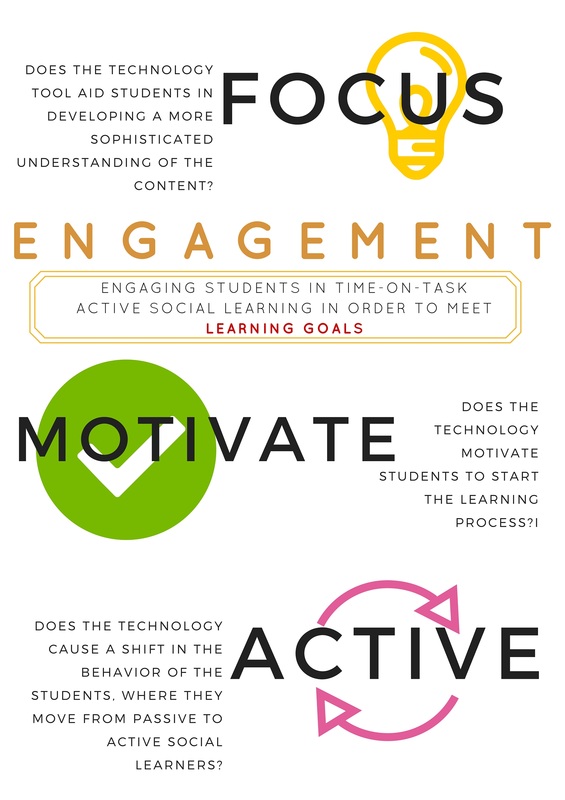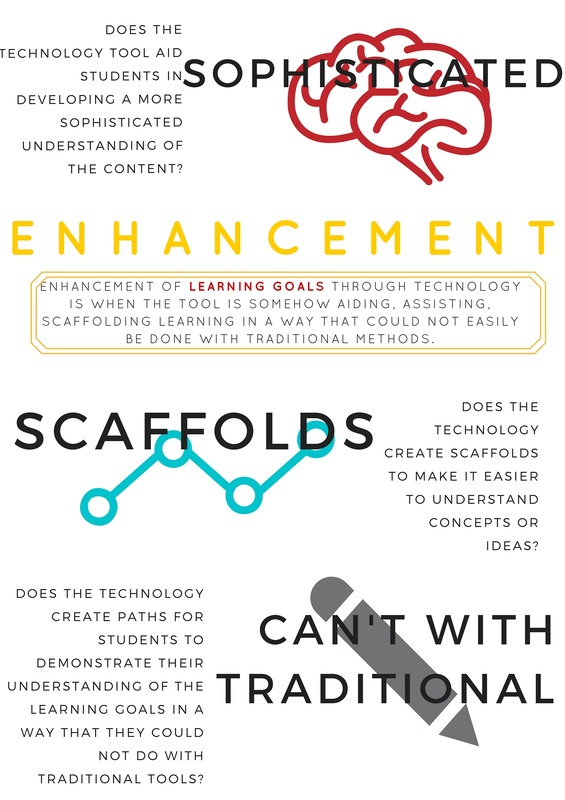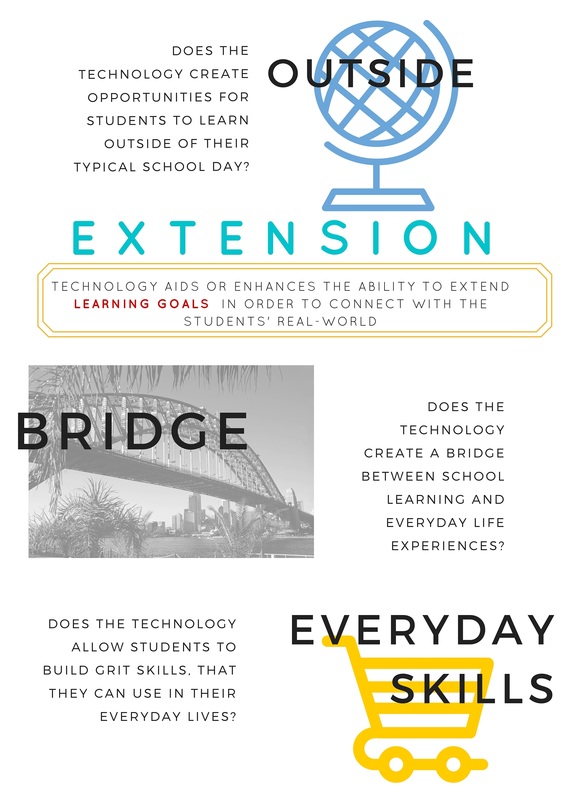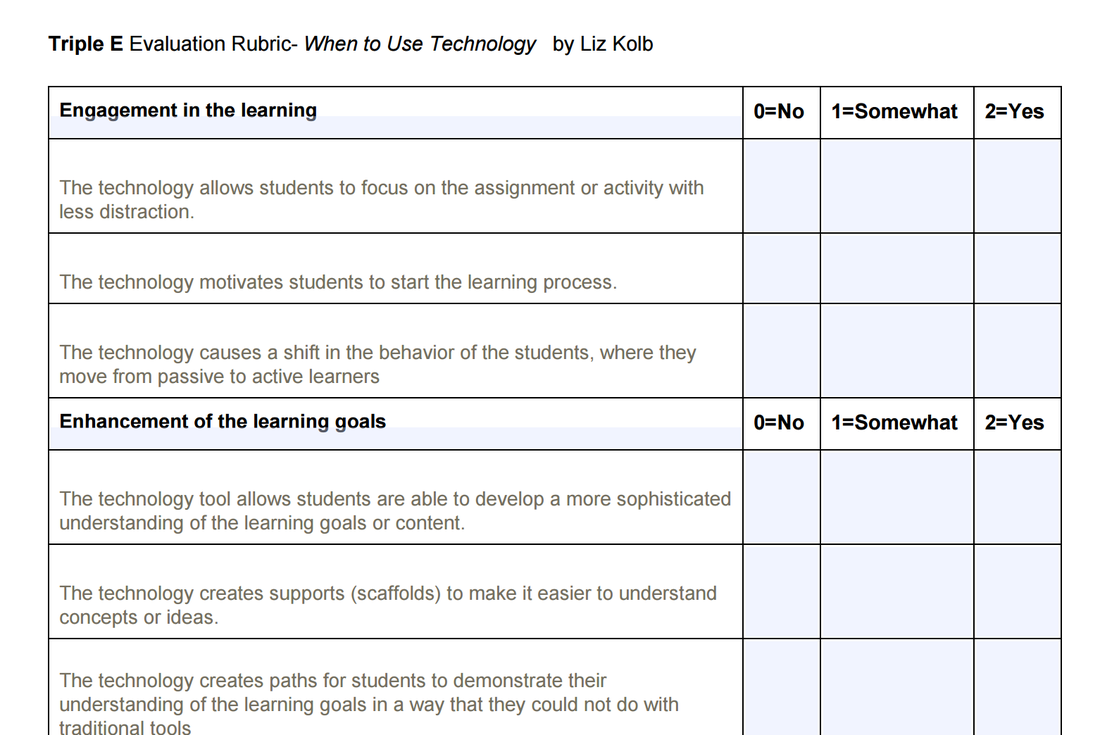EDU 807 Master - Week 2 - Triple E Framework - Summer 2018 - Group 3
1 Triple E Framework
2 About the Triple E Framework
3 Created by Dr. Liz Kolb, University of Michigan
4 http://www.tripleeframework.com/
|
6 What is the Triple E? 7 The Triple E Framework attempts to define what it should look like, sound like and feel like to integrate technology tools into teaching in order to meet and exceed learning goals. 8 The framework is based on three levels, Engagement in learning goals, Enhancementof learning goals, and Extension of learning goals. 9 While these terms are often used interchangeably, they are distinct and different. 10 The Triple E Framework defines each term and show examples of what makes each one unique and measurable.
11 The Triple E Framework is based on a considerable amount of research about what works and does not work when it comes to technology in learning. 12 In particular it emphasizes...
23 Read more about the research and links here
24 The Triple E Framework was developed in 2011 by Professor Liz Kolb at the University of Michigan, School of Education. The Triple E was created to fill a gap that has been pervasive in educational technologies---How to effectively integrate technology tools in K-12 learning so they have a positive impact on student achievement and learning outcomes.
25 WHY Triple E? The research on technology and learning over the past decade is fairly clear, technology should be integrated based on what we already know about good teaching and pedagogical practices. Dating back to the late 19th century, the foundation of current teaching practices is based on the work of pragmatism. Pragmatists like John Dewey (1897) pushed for learning to be embedded in the student's authentic everyday lives, socially constructed knowledge, active/hands-on learning and full of choice. Since the early 1990s Research has found that educational technology with a "drill and practice" approach often has no effects on learning or cognition. Yet, most technology tools created for education are still drill and practice and in the lower-order of Blooms Taxonomy.
26 Despite media often claiming a new piece of technology as a way to "revolutionize" learning, that is almost never the case. The Triple E framework takes this fallacy of technology as the magic bullet learning into account, and allows teachers to become critical consumers of making mindful choices around technology tools in their teaching. It is a simple framework, based on research, that helps educators create lessons that allow students to use technology to meet and add value to learning goals as active, social, creative learners, in authentic ways.
27
How Triple E is Different than other Tech Integration Models
28 Triple E Level 1: Engaged Learning
|










6 General Document comments
0 Sentence and Paragraph comments
0 Image and Video comments
General Document Comments 6


For this week, please look for a segment in each text where you can reply to the following:
What does this framework for using technology in education assume about teachers and teaching?
What does this framework for using technology in education assume about students and learning?
Please offer at least one comment related to the assumptions about teaching, as well as at least one comment on each document related to the assumptions about learning (2 initial comments). Then, please reply to at least two different classmates on one of their comments (2 responses).
New Conversation
Hide Full Comment Hide Thread Detail
What does framework say about teachers and teaching?
I think that this framework, along with SAMR and TPACK, recognizes that technology can truly change the nature of assignments to make them something that would otherwise not be possible without technology. The similarity I see between the three is that the technology integration must be coupled with the teachers unique understanding of the content. From this perspective the tools can really become transformative, but alone the tool is just a tool. It will be engaging at first but not truly enhance assignments.
I have personal experience with a director of one of the departments at our institution, who often argues for the purchase of technology solutions without having a problem that is to be solved. I won’t go into too much detail but this is a prime example of technology without pedagogy – and not ideal.
This framework assumes that teaching is pedagogically driven and technology is a powerful aid. This framework is also very goal oriented. I think this is powerful in terms of backward design as well. When designing a course or a module I think it is important to begin with the desired goal in mind and then design the instruction, including technology integration based on that.
What does framework say about students and learning?
It terms of learning, I think it gives learners the credit they deserve. Just because a class session incorporates a technology does not mean it will automatically engage learners. I think as advocates we need to to be careful of automatically making this assumption. For example, I recently created a series interactive case study modules. These labor intensive branching scenarios did have a lot of advantages over paper-based cases. However, the perceptions were more positive toward the content delivery than the interactive elements. We assumed learners would just like an ‘app-like’ interface. What we have actually found is that it is mixed. Our surveys show that many students just want a pdf to print out and read. In this example, the technology delivery might not have added as much value, but the ability to explore different scenarios did. So the technology aiding content delivery was the mix that really worked for learners.
We see this at my institution with some of our VR and 3D experiments as well. If they are not embedded in curriculum, they don’t really get used. Both faculty and students think they are impressive but the the technology integrations don’t make an impact because they are isolated.
Value-added is a term we use a great deal when discussing proposed integrations, and I see it repeated in this article. Value comes from transforming an assignment, expressing content in new ways and helping learners achieve their goals.New Conversation
Hide Full Comment Hide Thread Detail
Hi Adam,
How are you guys using VR at your institution? I could see that being incredibly impressive and a cool selling point for prospective students. However, with the technology being so new, I would not be surprised if many instructors do not have the pedagogical skillset to effectively leverage the technology as an effective learning tool. Additionally, I feel many users would use the technology for a quick wow factor and not dedicate enough time for students to build sufficient time-on-task engagement. Have you seen institution wide adoption rates or is it just a handful of power users using the tech?
New Conversation
Hide Full Comment Hide Thread Detail
Hi Ryan,
Right now most of the VR is demos. However we have a great deal of 3D embedded in curriculum. We have an Anatamage table, Z space and several purchased ipad apps that we use extensively to teach anatomy.
New Conversation
Hide Full Comment Hide Thread Detail
That’s awesome. I get jealous sometimes of other disciplines. Being theology and philosophy are so intangible, some technologies such as 3D elements (which I find myself personally drawn to) have little to no practical application.
New Conversation
Hide Full Comment
The Triple E theory operates within the frame work that technology is simply a tool and quality instruction is pedagogically driven. This frame work is in alignment with Clark’s (1994) article, Media Will Never Influence Learning. The two authors would agree that technology is simply a delivery format for the delivery of quality pedagogy and that technology alone cannot produce effective learning outcomes. Unfortunately, I have seen this framework demonstrated at our own institution through instructors conducting poorly designed online courses. In recent terms our institution has noticed that the implementation of poor online pedagogy and course design is strongly correlated to weak end of course surveys. In these cases the instructors are using the same tools and delivery format as their faculty peers. However, without quality online pedagogy the instructors end up delivering a very un-engaging and less effective online course.
From a learning perspective, the theory places a strong importance on learner motivation and engagement. Technologies can serve to enhance learners’ engagement; however, it is ultimately up to the learner to take an active role in the learning process. We see this in retention rates and learning outcomes for our online students. There is an observed relationship between students online activity logs (time engaging in the material) and outcomes (grades). The time-on-task active engagement plays a critical role in student success. Additionally, a student who yield low activity levels during the initial weeks of a course has been demonstrated to be one of the greatest risk factors in predicting course persistence.
Clark, R. (1994). Media Will Never Influence Learning. ETR&D, 42(2), 21-29.
New Conversation
Hide Full Comment